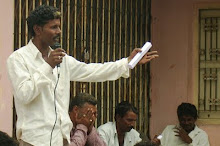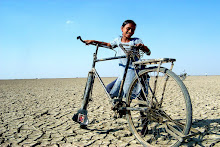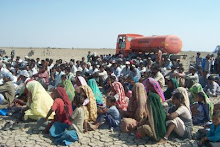Down to Earth: New Delhi: Wednesday, 15 December 2021.
Several rounds of research and help from non-profits, solar pumps suitable for salt makers’ needs was designed
The Agariya community the salt farmers of the Little Rann of Kutchh (LRK) is silently playing its part in curbing air pollution, even as the mechanised salt industry on the coastline of Gujarat continues to operate on subsidised thermal power.
Kanuben Patadia, a salt worker, is happy how her hands have been clean from not operating a diesel pump to extract brine, a step in the salt-making process.
In the last six years, she has prevented 15 tonnes of carbon dioxide from polluting the atmosphere. This translates to saving 12,000 metric tonnes of carbon dioxide in the last five years.
Carbon emissions saved (as per SAVE estimate)
Each solar pump saves 1,600 litres of light diesel oil from being consumed
Approximately 3,000 pumps installed since 2017-18 under the subsidy scheme (conservative estimate)
Oil consumed: 3,000*1,600 = 48,00,000 litres
@ 2.5 kg of CO2 generated / litre
Emissions that 4,800,000 litres would have generated:
4,800,000*2.5 = 12,000,000 kg
In the first part of the series, Down to Earth looked at how Agariya salt workers in LRK transformed their lives by using solar pumps to pump brine, instead of diesel generators.
Technical evolution
In 2008, Rajesh Shah of the Ahmedabad-based non-profit, Vikas Centre for Development (VCD), experimented with a windmill-based solution to diesel pumps. He had previously worked with the Agariyas on salt marketing.
“It didn’t work as wind velocity in LRK was high only towards the end of the salt-making season,” said Shah. VCD then approached NABARD for an interest-free loan to experiment with two solar pumps.
But they soon realised that the pumps installed could fetch only 50,000 litres of water per day as against the Agariya’s requirement of one lakh litres of water.
Saline Area Vitalisation Enterprise Ltd (SAVE), Vikas’ technical arm, did more research. In 2010, they designed a model suitable for the Agariyas’ needs. It converted direct current to alternating current and had a junction to switch fuel supply from solar panels to diesel for operating the same motor-pump set.
A solar water pump consists of photovoltaic panels, a controller and the motor-pump set. SAVE tweaked the controller standardised by the Union Ministry of New and Renewable Energy to suit local conditions.
Purushottam Sonagra of SAVE said:
“A standardised 3-kilowatt solar panel is designed for a single 3 horsepower (Hp) motor. Brine is heavier than water so it needs more power to lift. Also, the quantity of brine in wells is usually limited so, to fulfill his requirement, an Agariya has to dig three or more wells for which he needs three motors but of lesser power. We changed the algorithm of the controller such that it supplies power to all three 1 Hp motors that are installed in his wells.”
In 2014, SAVE researched further on the stand on which solar panels are mounted. “We found that a flexible stand helps to manually track the direction of the sun for optimal sunlight utilisation. A vertical tilting mechanism to adjust the panel to seasonal changes is also provided in the stand,” said Sonagra.
In 2014-15, the Self-Employed Women's Association (SEWA) also did a pilot with 200 solar pumps of 1.5 kW. “We found that a combination of solar power during the day and diesel during the night worked well as the expense of batteries to store solar power would increase the overall cost of the pump,” said Heena Dave, district coordinator, SEWA for Surendranagar.
Based on the results, SEWA began installing pumps with a higher power of 2.7-3 kW.
Two kinds of solar pumps commonly seen in the LRK today are the nine-panelled pumps with a stationary stand and a 12-panelled pump with a movable stand.
Several rounds of research and help from non-profits, solar pumps suitable for salt makers’ needs was designed
The Agariya community the salt farmers of the Little Rann of Kutchh (LRK) is silently playing its part in curbing air pollution, even as the mechanised salt industry on the coastline of Gujarat continues to operate on subsidised thermal power.
Kanuben Patadia, a salt worker, is happy how her hands have been clean from not operating a diesel pump to extract brine, a step in the salt-making process.
In the last six years, she has prevented 15 tonnes of carbon dioxide from polluting the atmosphere. This translates to saving 12,000 metric tonnes of carbon dioxide in the last five years.
Carbon emissions saved (as per SAVE estimate)
Each solar pump saves 1,600 litres of light diesel oil from being consumed
Approximately 3,000 pumps installed since 2017-18 under the subsidy scheme (conservative estimate)
Oil consumed: 3,000*1,600 = 48,00,000 litres
@ 2.5 kg of CO2 generated / litre
Emissions that 4,800,000 litres would have generated:
4,800,000*2.5 = 12,000,000 kg
In the first part of the series, Down to Earth looked at how Agariya salt workers in LRK transformed their lives by using solar pumps to pump brine, instead of diesel generators.
Technical evolution
In 2008, Rajesh Shah of the Ahmedabad-based non-profit, Vikas Centre for Development (VCD), experimented with a windmill-based solution to diesel pumps. He had previously worked with the Agariyas on salt marketing.
“It didn’t work as wind velocity in LRK was high only towards the end of the salt-making season,” said Shah. VCD then approached NABARD for an interest-free loan to experiment with two solar pumps.
But they soon realised that the pumps installed could fetch only 50,000 litres of water per day as against the Agariya’s requirement of one lakh litres of water.
Saline Area Vitalisation Enterprise Ltd (SAVE), Vikas’ technical arm, did more research. In 2010, they designed a model suitable for the Agariyas’ needs. It converted direct current to alternating current and had a junction to switch fuel supply from solar panels to diesel for operating the same motor-pump set.
A solar water pump consists of photovoltaic panels, a controller and the motor-pump set. SAVE tweaked the controller standardised by the Union Ministry of New and Renewable Energy to suit local conditions.
Purushottam Sonagra of SAVE said:
“A standardised 3-kilowatt solar panel is designed for a single 3 horsepower (Hp) motor. Brine is heavier than water so it needs more power to lift. Also, the quantity of brine in wells is usually limited so, to fulfill his requirement, an Agariya has to dig three or more wells for which he needs three motors but of lesser power. We changed the algorithm of the controller such that it supplies power to all three 1 Hp motors that are installed in his wells.”
In 2014, SAVE researched further on the stand on which solar panels are mounted. “We found that a flexible stand helps to manually track the direction of the sun for optimal sunlight utilisation. A vertical tilting mechanism to adjust the panel to seasonal changes is also provided in the stand,” said Sonagra.
In 2014-15, the Self-Employed Women's Association (SEWA) also did a pilot with 200 solar pumps of 1.5 kW. “We found that a combination of solar power during the day and diesel during the night worked well as the expense of batteries to store solar power would increase the overall cost of the pump,” said Heena Dave, district coordinator, SEWA for Surendranagar.
Based on the results, SEWA began installing pumps with a higher power of 2.7-3 kW.
Two kinds of solar pumps commonly seen in the LRK today are the nine-panelled pumps with a stationary stand and a 12-panelled pump with a movable stand.
















.jpg)
.jpg)
.jpg)
.jpg)













No comments:
Post a Comment